若敏
若水上仁堪養性 敏思椽筆自陶情《南極之戀(10):copper Bay 遇見馬可羅尼企鵝》
若敏
Day 8 – December 26, 2019 – Cooper Bay, South Georgia
Latitude: -56.65° Longitude: -40.76°
2019年12月25日在Salisbury Plain平原與王企鵝親密接觸之後,Quest郵輪從南喬治亞島的西北海岸往東南方向駛去。
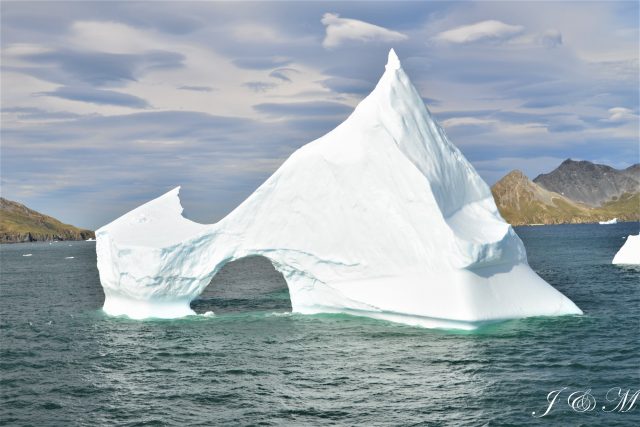
12月26日清晨,我們到達了風景如畫的庫珀灣(Cooper Bay)。從地圖上可以清晰地看到庫珀灣和庫珀島的位置。

庫珀島是一個小島,長2英裏(3.2公裏),位於南喬治亞島東南端,在Drygalski峽灣入口的北側。 它是由英國探險隊在詹姆斯·庫克(James Cook)於1775年發現的,並以跟隨庫克船長到達此地的羅伯特·帕利瑟·庫珀(Robert Palliser Cooper)中尉名字命名。
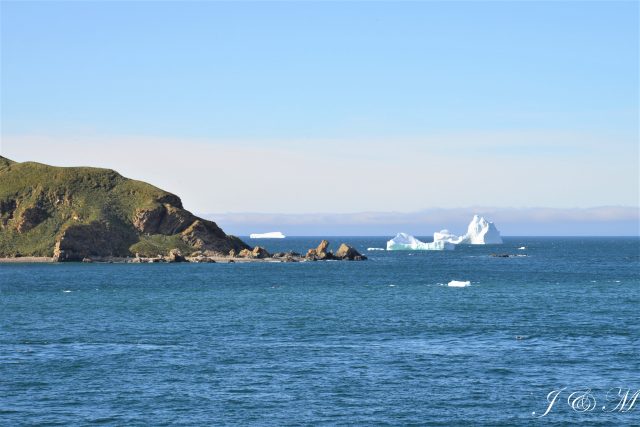
一條可通航的水道Cooper Sound寬約1英裏(1.6公裏),將Cooper島與南喬治亞主島的海岸隔開。 有一個小海灣,稱為庫珀灣(Cooper Bay ),位於大陸上海角Vahsel西南1.3英裏(2.1公裏)和庫珀島西北1英裏(1.6公裏)處,向南喬治亞島的東南端縮進,其名稱源自庫珀島。該島的最高點達到416米(1,365英尺),島的上部高於雪線。

船上的專家介紹說:早年捕鯨船將大陸上的老鼠帶到南喬治亞島,導致老鼠泛濫,破壞了動植物的生態平衡,近幾年的滅鼠行動,初見成效,而庫珀島是極少數的無老鼠島之一,是南喬治亞島的特殊保護區,擁有大量海鳥,12,000對黑眉信天翁,王企鵝、帽帶企鵝和金圖企鵝,特別是有20,000隻馬可羅尼企鵝(也叫通心粉企鵝)。 還有許多海狗和海豹,這裏是為數不多的未被人類涉足的地方之一,島上滿是草叢。

我們郵輪的錨地,坐落在庫珀島(Cooper Island)和庫珀灣(Cooper Bay)之間,船上的攝影師用無人機拍攝出的景色令人歎為觀止。一般遊客是不能攜帶無人機上船的,攝影師是以郵輪公司的名義,花重金才申請到許可證。

推開涼台門,眼前的景致讓我一歎再歎,千年冰凍的淡藍色冰塊,純粹和精致,千姿百態。大自然的鬼斧神工,讓人類的想象空間無限放大,人工無法雕琢出如此空靈而純淨的藝術品,無法用言語解讀和表達心中的讚美和震撼。
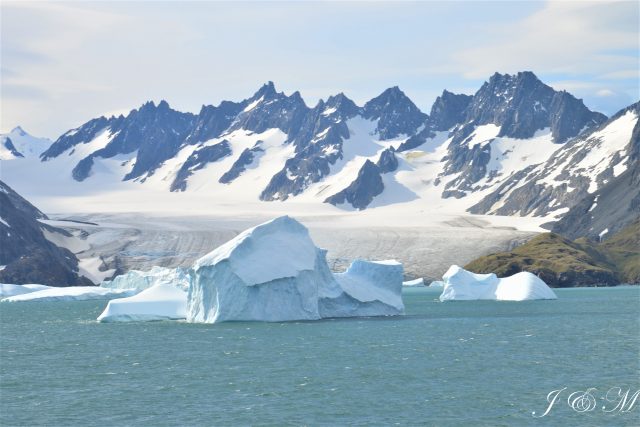
運氣實在是不錯,湛藍的天空,通透清澈,遠遠望去,大大小小的冰山,在海中漂浮。船長在廣播中告知大家,我們遇到了難得一見的好天氣。但是海灘上布滿了企鵝和海豹,出於對繁殖期動物的保護,這裏不能登陸,隻能巡遊,而我們紅隊將在早上8:00第一批參加巡遊。

吃完早餐後,就穿上衝鋒衣,帶齊所有裝備,廣播聲如同號角一般吹響,我和Jack急忙走向集和地點,換上雪地靴。

動作快,讓我們第一批登上衝鋒艇,舵手是來自菲律賓的探險隊員Hansen,他輕車熟路地把衝鋒艇開到了馬可羅尼企鵝(Macaroni penguin)棲息的海岸山崖邊。
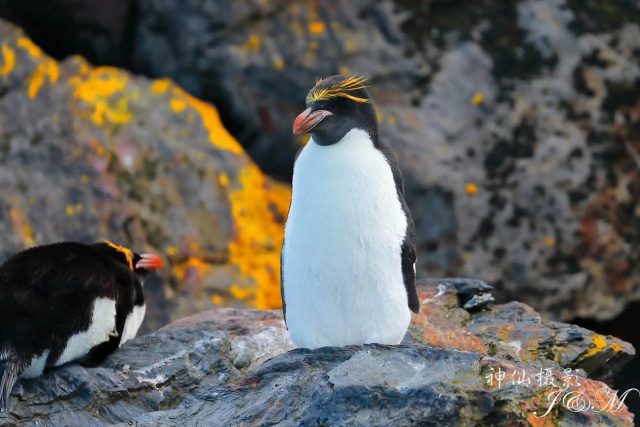
這是我第一次看到馬可羅尼企鵝,頭上裝飾著金黃色的鳳冠,紅色的丹鳳眼,看起來有點誇張,但很威嚴,別看它個頭不大,卻勇敢地生活在風高浪急的海岸懸崖上,練就了在惡劣環境下求生的本領。在求偶時,雄企鵝常常載歌載舞,以求得雌企鵝的青睞。一旦抱得美人歸,寵愛有加,形影不離,溫情脈脈,可謂企鵝裏的愛情典範。這種企鵝體型不大,身高約七十厘米,體重3.5-4公斤重。在陡坡上行走是它的強項。
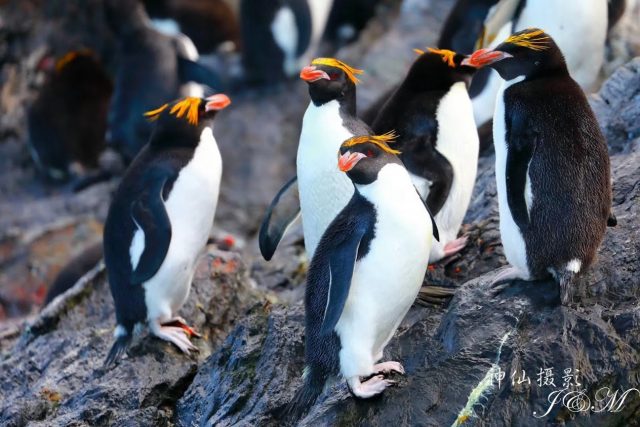
馬可羅尼企鵝,又稱長冠企鵝、通心粉企鵝,1873年,由德國科學家約翰.勃蘭特(Johann Friedrich von Brandt)命名。它的學名(chrysolophus )取自古希臘語,為金色頭冠之意。這是由於馬可羅尼企鵝的頭頂上有幾束標誌性的金色羽毛。
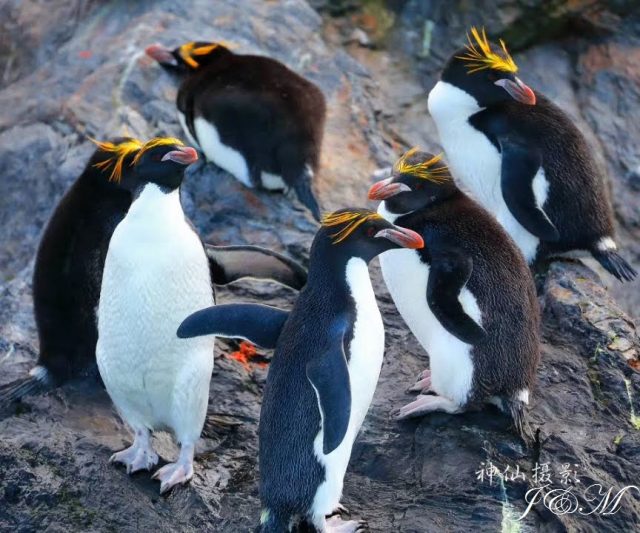
「馬可羅尼」聽起來特別熟悉,沒錯,確實是來自英文的「Macaroni」,而這個企鵝的名字又源自於英國的南極探險家們,當時這個字多指18世紀英國的一群人,他們崇尚義大利文化、生活奢侈、打扮時髦,也常常旅行,炫耀自己的冒險經曆,用各種話題和裝扮,證明自己的高貴和脫俗。類似於國內最近熱門的“凡爾賽“話題,大概是當初發現這群小企鵝的時候,英國探險家認為它們的金色鳳冠和這群花花公子的髮型十分相似,也因此賦予了馬可羅尼的稱呼。

馬可羅尼企鵝的第二個名字「長冠企鵝」,是根據它們長長的金黃色鳳冠而來。但是,馬可羅尼企鵝為什麼會有「通心粉企鵝」的稱呼呢?其實馬可羅尼企鵝與通心粉沒有什麼直接關係,隻是Macaroni最常用的中文翻譯就是通心粉,一開始可能是字麵翻譯的關係,但是現在通心粉企鵝的名字也廣為流傳。金黃色的鳳冠看起來挺像通心粉的形狀,也漸漸地被人們所接受。

馬可羅尼企鵝曾經是繁殖數量最多的企鵝之一。不幸的是,自1970年代以來,在南喬治亞州的馬可羅尼企鵝數量已大大減少,從20世紀70年代到21世紀初,馬可羅尼企鵝繁殖的數目下降了70%以上。人們認為這種下降,有一部分原因是由於南極海豹海鳥種群的不斷恢複,馬可羅尼企鵝遇到天敵捕殺幼企鵝,另外海豹與之爭奪磷蝦,海洋學變化影響了他們覓食地區食物供應等,都是原因之一。探險隊員說,如果按照這樣的速度下降,不久的將來,馬可羅尼企鵝就會走到瀕臨危險的邊緣。大自然的生存法則就是如此,讓人扼腕。

除了馬可羅尼企鵝,在庫珀灣還可以看到王企鵝King,金圖企鵝Gentoo和帽帶企鵝Chinstrap。世界上沒有多少地方可以在一個位置看到四個企鵝物種。庫珀灣便是其中之一,確實令人大飽眼福。巡遊中,還看到巨鸌、藍眼鸕鶿、象海豹等眾多的野生動物。巡遊時,天氣非常好,望著周邊的冰山和灣裏五彩的海帶,心情愉悅。
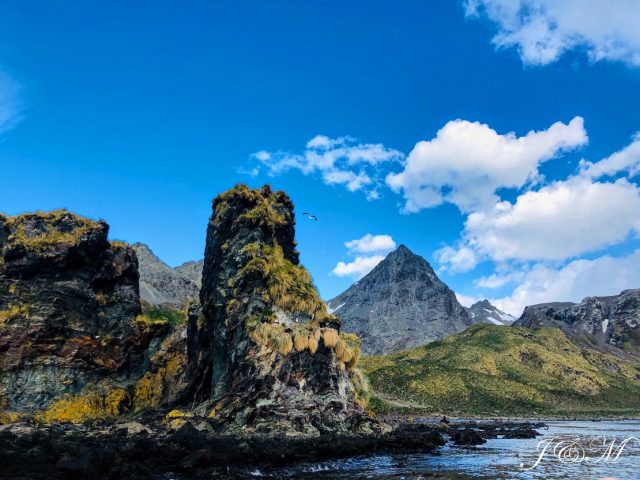
庫珀灣有起伏的山巒和冰川,較低的山坡上覆蓋著一層翠綠的草叢。企鵝和海豹,在海灣的沙灘上、草叢中繁殖,蛻皮和覓食。這裏是動物的天堂。

忽然,探險隊員指著岸邊一隻睡著的豹斑海豹說,這是企鵝的殺手,它最喜歡的食物就是企鵝。但是,海豹周圍有許多穿梭的王企鵝和金圖企鵝,似乎並不畏懼豹海豹的存在,我們十分好奇,探險隊員介紹說,豹海豹已經吃飽了,正在睡覺,養精蓄銳,所以不會打擾企鵝,一旦進食的時間一到,小企鵝就難逃魔掌了。王企鵝個頭太大,它一般不會去吃,遇難的是個頭小一點的企鵝,馬可羅尼企鵝,在這裏常常首當其衝地被吃掉。

我們坐在衝鋒舟上盡情地欣賞著天空、岸邊、水上的各種飛禽走獸的精彩表演,90分鍾的時間,一下子就過去了。順利地返回大船,接著去聽了講座,享受美食,午飯後,Quest就啟航了,一路向南。

意外的收獲是在船上看到南極特有的柱狀雲。柱狀雲Lenticular clouds 在對流層形成,通常垂直於風向。它們的外觀通常可與碟子媲美。平流層下部形成的珠狀雲有時具有透鏡狀。柱狀雲主要有三種類型:高積雲直立柱狀透鏡(ACSL),平積層直立柱狀透鏡(SCSL)和卷積直立柱狀透鏡(CCSL),它們在地麵上的高度不同。由於它們的獨特外觀,有點像不明飛行物(UFO)。

在離開庫珀灣時,Quest郵輪在船長的帶領下,經過Drygalski峽灣的入口,那裏是一群冰山聚集的地方,海與天,冰與雪,藍與白兩種顏色交替著在眼前出現,讓人沉浸在夢幻般的詩情畫語之中,無邊的寂靜中,隻有來自冰山間隙中的呢喃,進入忘我,忘記寒冷,忘記喧囂的塵世,感歎大自然的天然雕琢和出神入化,沉浸在美麗的遐想之中。風越來越大,宣告著我們的船正在進入西風帶。
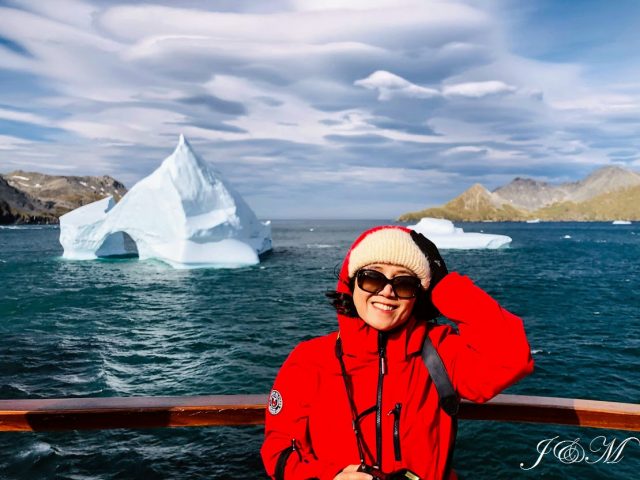
結束了庫珀灣的巡航,南喬治亞島的航程即將進入尾聲,我們依依不舍與之告別。目睹企鵝們與惡劣的環境和天敵不斷地抗爭,生生不息地繁衍著後代,感慨萬千。馬可羅尼企鵝勇敢地站在海邊懸崖上的身影,深深地觸動著我。南極之行,讓我更加體會到,一定要珍愛和保護地球上的最後一片淨土。
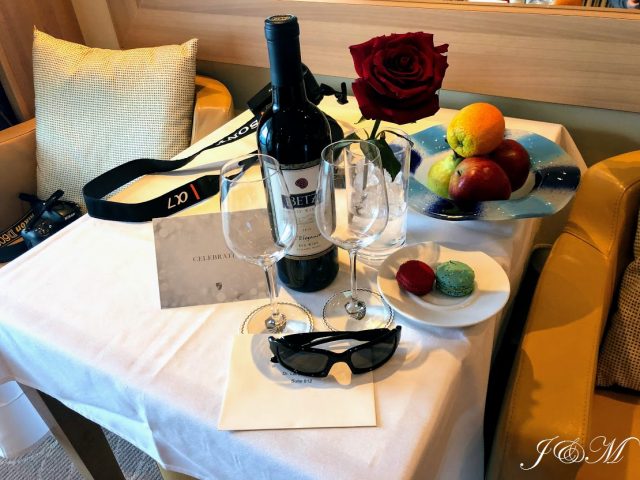
這一天是Jack的生日,這次南極之行也是為他定製的生日禮物,我們幸運地在SeaBourn Quest郵輪上的米其林Grill by Thomas Keller 餐廳訂到了位置。服務員貼心地疊了一個毛巾小熊,並附上祝賀的話語。船上還特別贈送了一瓶紅酒。

生活中是需要儀式感的。村上春樹說過:“儀式感是一件很重要的事,如果沒有這些小確幸,人生不過是幹巴巴的沙漠而已”。到美國後,慢慢接受了美國文化裏那些有儀式感的形式。中國的文革十年,曾經將儀式感碾壓到極致,泯滅了人間的善良和美好。其實無論愛情、親情還是友情,儀式感是很好的感情紐帶,因為表達了內心的關注和重視,有著不可替代的溫暖。
[caption id="attachment_349361" align="alignnone" width="640"]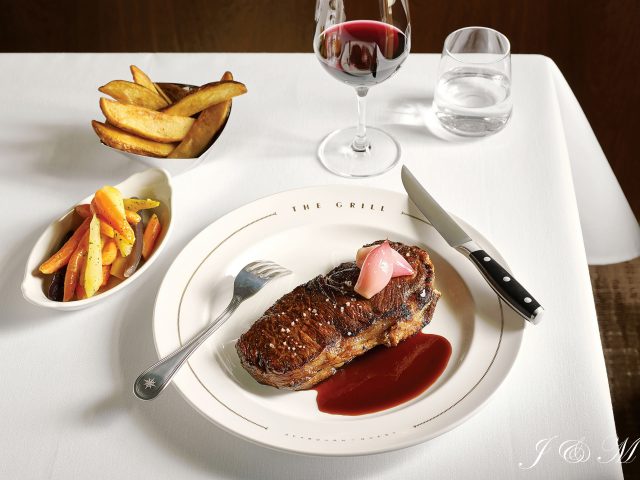 Thick-cut Prime NY Strip Steak by The Grill by Thomas Keller on board Seabourn Quest (PRNewsFoto/Seabourn)[/caption]
Thick-cut Prime NY Strip Steak by The Grill by Thomas Keller on board Seabourn Quest (PRNewsFoto/Seabourn)[/caption]
儀式感是什麽?它讓生命裏的某些時刻變得獨一無二,感覺有人疼,有人愛,不枉來世一程,生活裏不是隻有柴米油鹽醬醋茶,還有琴棋書畫詩酒花。
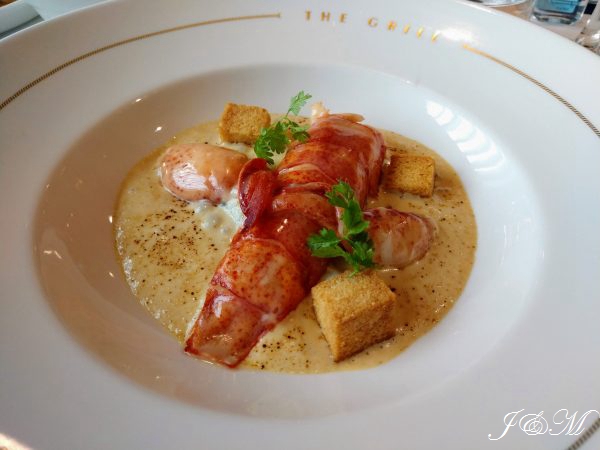
(我的主菜是龍蝦)
讓尼采的名言成為這個特別日子的結尾:“每一個不曾起舞的日子都是對生命的辜負。”

這篇遲來的祝福送給Jack!
Jack,生日快樂!
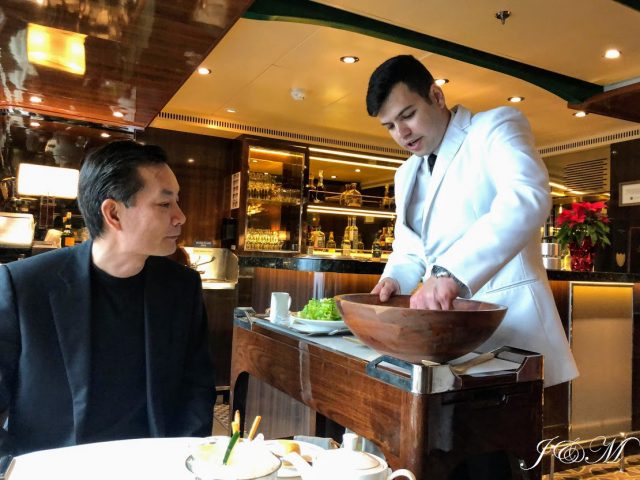
(餐廳手工製作凱撒沙拉)
最後,附上船上探險隊員的英文日記,作為留念和記錄。
After a spectacular adventure yesterday in the Bay of Isles, Quest made its way from the north-western shore of South Georgia to its south-eastern tip. We arrived early this morning in the picturesque Cooper Bay, porpoising penguins and fur seals escorting us to our anchorage. Nestled between Cooper Island and Cooper Bay, the views from Quest were breathtaking, made even better by the clement conditions. A combination of light winds, a blue, sunny sky that was later transformed by stacks of lenticular clouds that are a characteristic feature of the South Georgia skies, showed off the island in all its glory. The rugged mountainous topography dissected by the Quensel Glacier, and cloaked on the lower slopes by a verdant green layer of tussac grass with a multitude of wildlife breeding, moulting and foraging along the coastal strip, the inshore waters teeming with penguins, seals and petrels, and a number of icebergs in the waters offshore all made for an awe-inspiring experience. And, this was our experience of Cooper Bay before we had even left Quest to explore the nooks, crannies and beaches of the bay by zodiac. Heading out on the zodiacs across the calm, sparkling sea towards the shore, we came across playful seals in the water, and upon arriving in the inshore zone, festooned with kelp, we were afforded wonderful views of a variety of penguins ashore.
This was our first opportunity to see the magnificent Macaroni Penguins, regally adorned with their bright yellow head plumes. Their common name harks back to the 'dandies' - the young wealthy men of 18th century Britain who attired themselves extravagantly, donning hats with fanciful feathers. In order to expand their knowledge of arts and culture, it was common for the dandies to undertake a grand tour of Europe. They returned with stories of their sophisticated adventures, and all sorts of accoutrements that served as proof of their increased level of worldliness. During this time, the dandies acquired a taste for macaroni pasta from Italy and started importing it in large quantities to Britain. This led to a new nickname for the feather-hatted dandies - the Macaronis. When early English seafarers first encountered the curious looking penguin in the sub-Antarctic resplendent with yellow head plumes, they were reminded of the Macaronis back home, and so the species was named.
The Macaroni Penguin is the world's most abundant penguin, and it is also the most numerous penguin breeding at South Georgia, with a population of approximately 1 million breeding pairs. Although large, the South Georgia population has unfortunately declined substantially since the 1970s when it was estimated to number almost 5,5 million pairs. This decline is thought to be due, at least in part, to the ongoing recovery of the Antarctic Fur Seal population with which the Macaroni Penguins compete for krill, together with oceanographic changes that have influenced the availability of food in the areas they forage. The broader Cooper Bay area supports approximately 25,000 pairs of Macaroni Penguins, with about 100,000 pairs breeding at Cooper Island, across the way.
In addition to the Macaroni Penguins, we were also able to see King, Gentoo and Chinstrap Penguins. There are not many places in the world where it is possible to see four penguin species in a single location. Cooper Bay is one of those locations. Some of the other highlights from an ornithological perspective included Light-mantled Albatrosses harnessing the winds to soar elegantly in the bay, South Georgia Shags nesting amongst tussac clumps on the faces of the coastal cliffs, both Northern and Southern Giant Petrels loitering on the beach in search of weak or dead birds and seals to kill or scavenge. And who can forget the ubiquitous and characterful sheathbills. These inquisitive and quarrelsome birds continually scrap over food items, or potential food items, whether this means niggling away at the flesh of a seal or bird carcass on the beach, intercepting the food that adult penguins attempt to regurgitate for its chick or foraging on freshly deposited penguin guano. These, and almost anything organic, are all on the sheathbill's menu. Novel items, such as tourists' boots or tripod legs are routinely inspected by the industrious sheathbills in case they prove to be edible.
We were also treated to a variety of the region's seals. In addition to the two abundant and commonly accounted species that we observed over the previous two days - Antarctic Fur Seals and Elephant Seals - we were afforded good views of a Leopard Seal resting on the main beach of Centre Cove.
After a fantastic day out on the zodiacs, it was time to leave the wonderland of Cooper Bay to start making our way further south for the next chapter of our adventure. As we passed the entrance of Drygalski Fjord, where a group of icebergs had assembled, the wind increased as if to indicate we were entering the realm of the gale birds. A little while later, we passed Cape Disappointment, the last land we will see until we reach Antarctica.
Cape Disappointment was named by Captain James Cook during the second of his three voyages of exploration aboard the HMS Resolution. Cook circumnavigated the world in search of the 'Southern Continent'. In January 1775, the Resolution arrived at the entrance of Possession Bay along the north coast of South Georgia, where Cook made the first landing on the island. He hoped that this land would prove to be part of Antarctica, the Southern Continent. However, when they rounded the southernmost promontory, and looked northwest to the point at which they had arrived five days earlier, Cook realised that what he thought might be the continent was plainly a long narrow island. He named it the Isle of Georgia in honour of King George III. Understandably, he named this southern promontory Cape Disappointment.
Our visit to South Georgia was the antithesis of disappointing, and we departed feeling exhilarated by the adventures experienced there and excited about those still to come.
Written by Anton Wolfaardt – Photos by Aidan Klimenko and Kieran Buckley
(攝影Jack、若敏,選用神仙的幾幅攝影作品,十分感謝,還有幾幅攝影來自船上攝影師,一並致謝)





+1
感謝鼓勵!
謝謝評論,想起一年前的旅行,依然心潮難平。問好!
謝謝你的評論,唯有愛和美食不可辜負,太讚同了!
謝謝菲兒的沙發,你的鼓勵暖心。